|
Your new movie Valley
of the Sasquatch a.k.a. Hunting
Grounds - in a few words, what is it about?
Valley
of the Sasquatch
is the story of a family going through a
rough time. After a series of unfortunate events, Roger and his teenage
son Michael find themselves forced to move into an old family cabin on
Mount St. Helens. Michael, a city kid, doesnít like being moved away
from his comfort zone and Roger is faced with dealing with his son by
himself for the first time in his life. As these two try, and fail, to get
along in this new environment, they find themselves in the path of a tribe
of Sasquatch that arenít too excited about the influx of humans into
their territory. Basic
question, why Bigfoot? I
was fascinated by Bigfoot
from an early age. It probably started with
seeing Harry and the Hendersons on TV when I was a kid. That led to
me reading books on the subject and becoming obsessed with paranormal
investigation shows such as Unsolved Mysteries. Iíd devour any
story or movie about Bigfoot
that I could find. The reason they appealed
to me was because Iím such a big fan of monsters, but I knew that things
like werewolves and vampires werenít real. Bigfoot
was a scary creature
that I could believe in, and I am a believer. I just love the idea that
there is this mythical beast out there in the woods just waiting to be
discovered and change the way we think about the world. With
Valley of the
Sasquatch being a monster movie, is that a genre at all dear to
you, and some of your genre favourites? Iím a huge horror
movie fan and Iím always down to watch a good monster movie. My favorite
horror film of all time is a monster movie: An American Werewolf in
London. Give me an out of this world villain made out of foam latex
and Iíll be happy. Some other genre favorites that fit in that mold for
me are The Thing (1982), Gremlins, Fright Night
(1985), Night of the Creeps,
From Dusk Till Dawn, and
The
Return of the Living Dead.
Other sources of
inspiration when writing Valley
of the Sasquatch? When writing I try to make sure
that the characters and their relationships are just as important as the
horror. If you donít give the audience the opportunity to become
invested in the drama of the film, thereís no reason to expect them to
care when the characters begin dying. So when writing the script I thought
of films that did this well and also featured a small number of characters
who find themselves out of their element fighting against an unknown
enemy. The ones that immediately pop into my head that I was thinking
about at the time are The Descent and 1977ís
Rituals.
But the single biggest inspirations when writing Valley
of the Sasquatch were the true
stories of Bigfoot
encounters that I had been reading about since I was a
kid. The plot of the film is a fictionalized story containing many
references to real life sightings. I wanted this to be a story that
appealed to Sasquatch enthusiasts as much as horror fans. By taking
inspiration from a handful of real life events, I hoped to craft a story
that respected the history of the creature and didn't just treat
Bigfoot
as a rampaging monster and nothing more. What can you tell us about
your directorial approach to your story at hand? My
approach when directing was the same when writing, keep the characters and
the sense of reality as the most important things in the film. If it felt
real for the actors when they were performing, it would feel real for the
audience when they were watching. In rehearsals and on set I would spend a
lot of time talking with the actors about where their characters were
coming from and what they had been through, and that includes our suit
performer who played the Bigfoot.
This isn't a movie that exists in a heightened reality, itís
happening in our world. Thatís why the monster they run into is Bigfoot and
not something fantastical like The Mummy. These are real people, dealing
with problems we can relate to, who find themselves face to face with a
real monster. Keeping that fact in mind during every scene was the most
important thing for me.
|
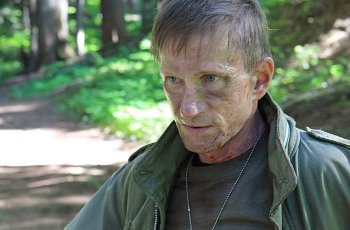
Bill Oberst jr |
There
are quite a few gruesome bits in Valley
of the Sasquatch - so what can you tell us about the gore effects
in your movie, and was there ever a line you refused to cross regarding
violence (for other than budgetary reasons)? Iím of two
minds when it comes to horror: Iím a lover of character and story, but
Iím also a gorehound who wants nothing more than to see a good death
scene that is inventive and doesn't wallow in nastiness. I tried
to balance these interests within Valley
of the Sasquatch. I didn't want the film
to devolve into a series of random death scenes featuring underdeveloped
characters. At the same time, I didn't want the death
scenes to feel rote. For example, thereís nothing worse than watching a
slasher movie and every single death is a knife to the gut. It gets
boring. I hope that when the death scenes happen in Valley
of the Sasquatch theyíll mean
something to the audience because they either care about the characters or
because they havenít seen that scene before in a Bigfoot
film. You just
have to talk about your actual creatures/creature suits for a bit! Our
suit was created by the same man who brought our gory scenes to life. His
name is Doug Hudson and heís been working in makeup FX for over 20
years. Iíd heard of Doug because heís the only guy in the Seattle film
scene who has a Bigfoot
suit. He would bring this suit to horror
conventions and it appeared in some local commercials. There are plenty of
good Bigfoot
films that have to constantly hide the creature because
itís just a guy in a gorilla costume. Since I wanted the Sasquatches in
our film to be real characters that I could go in and get close-ups on I
knew the suit would be one of the most important things in the film. So
thatís why I went to Doug. We made sure to put aside a good chunk of the
budget for the makeup FX, so Doug was able to build a whole new suit and
mold a new head based on specific looks we had both discussed.
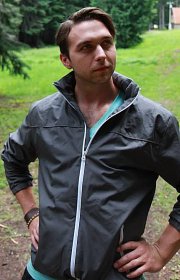
D'Angelo Midili |
But a good suit is only half the battle in making sure your creature seems
realistic. If the performer inside the suit stinks then itís all for
naught. Luckily Doug helped us out in this regard by recommending the suit
performer he had used in the past, Connor Conrad. I had seen Connor in
Dougís old suit and thought he brought a lot of personality to his
creature performance. He was also comfortable with Doug and the entire
process of wearing a hot suit for long periods of time, so it was a no
brainer to go with him. A big thing that Doug and I decided with the suit
was to use Connorís real eyes as the eyes of the Sasquatch. One of my
favorite scenes in the whole movie is near the end, where we hold on a
close-up of the Sasquatch. We didn't have the budget for
animatronics in the suit, but by seeing Connorís eyes and the way he
moves his tongue and his chin, you feel like this immobile mask is a
living, breathing creature. You wouldn't have gotten that with a
lesser performer, a lesser suit, or a CGI creation. What
can you tell us about your cast, and why exactly these people? Iíll
go in the order they were cast:
Bill Oberst jr [Bill Oberst
jr interview - click here] plays Bauman in the film. Our producer Matt Medisch was a
big fan of Billís and a film he had seen him in called The Retrieval. I
looked up Bill and realized I had seen him in a bunch of stuff; the
guyís been in over 100 movies in the last 5 years! So we reached out and
Bill reacted well to the part, which was a change of pace from his usual
villainous roles, and the script. He liked the fact that it was a more
dramatic take on a horror film and enjoyed my enthusiasm for the subject
matter.
David Saucedo [David Saucedo
interview - click here] was someone that our other producer Brent Stiefel
recommended. He had worked with David before and once he recommended him I
remembered seeing David in Paranormal Activity: The Marked Ones. I looked
into his work, liked what I saw, and then we started discussing the part.
One thing that people might not realize since the character of Sergio is
such a jerk in the film is that David is super nice, so we got along well
on set.
|
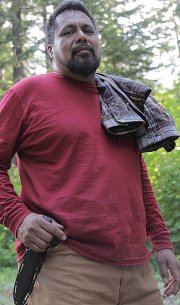
David Saucedo |
The character of Will was the hardest to cast. I originally had an idea
that all of the characters in the film besides Michael would be in their
40s. But after looking around at a bunch of performers in that age range
we realized we weren't seeing what we were looking for with
Will. So we opened up the age range and since the character is supposed to
be this fit likable guy, DíAngelo Midili jumped right to
the top of our list. I've worked with DíAngelo on everything I've ever
directed, which up until Valley
of the Sasquatch were short films and web series.
He even played a major character in the first feature I wrote, The
Invoking. As soon as I saw him reading the lines, I couldn't believe
that I had ever considered anyone else. Casting someone younger also helped
with the character dynamics since Roger and Sergio were supposed to be
somewhat jealous of Willís success in life. Having him be younger than
them and more successful just gives more fuel to their characterís
resentments.
We ran into some trouble two weeks before production when our original
Michael and Roger both dropped out of the film for different reasons. We
had to act fast since there was no delaying production at that point and
we didn't have our two main characters cast. Luckily we
were friendly with Elias [Elias
interview - click here], the director of the film Gut. We asked him about
actors he would recommend us taking a look at and he introduced us to
Miles Joris-Peyrafitte [Miles
Joris-Peyrafitte interview - click here] and Jason Vail [Jason
Vail interview - click here]. We asked them to submit audition
videos and they were easily the most talented people we saw read for those
parts. We also had the added bonus of the fact that they looked like they
could be father and son, Miles had even played a younger version of
Jasonís character in Gut. With such a quick turnaround between casting
and production, I didn't get much of a chance to rehearse with
Miles and Jason before we were on set, but they both fell into
character quickly and knocked it out of the park.
A
few words about your locations, and what was it like filming there? We
shot the film near Snoqualmie Pass in my home state of Washington. We
chose a location that looked great and was also practical for us to shoot
in. We had a cast and crew that we had to put up for a month and having a
place close by the shooting locations was important for us to make our
days. We couldn't waste an hour each day driving to and from a
mountain location. Luckily we found Meany Lodge, a ski lodge that was
off season since we filmed in the summer. We could house the cast and crew
in the ski lodge and then walk a few hundred feet in any direction and
find ourselves in a variety of locations. They even had an old telephone
cabin that became the characterís home in the film.
|
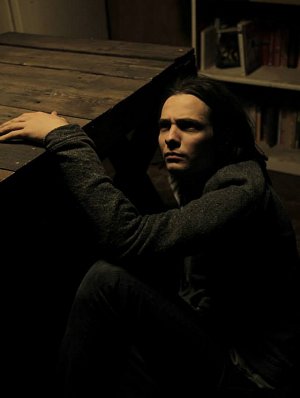
Miles Joris-Peyrafitte |
What
can you tell us about the shoot as such, and the on-set atmosphere? The
shoot was great. We shot for four weeks from the middle of June to the
middle of July. We didn't have a large budget, but it was
important to me and my fellow producers at The October People that we have
as much time as possible to bring the script to life. This urge probably
comes from the fact that our first film The Invoking was shot in just 7
days. So for a month we had the cast & crew all living at Meany Lodge.
We were never away from each other and this made it so people became very
close. We were all stuck in an area with no phone reception or WiFi,
working to bring this story to life. And when we weren't shooting
we were talking, drinking, and watching movies. It was a lot of fun, like
a gory summer camp. The
$64 question of course, when and where will the film be released onto the
general public? We just recently started our film festival
run. Our next showing that has been announced will be at the Crimson
Screen Horror Film Festival in Charleston, SC on the weekend of May 15th.
Exact show times aren't available yet, but will be coming soon.
There are also other festivals we've submitted to that we are
waiting to hear back from, so weíll have some more screenings to
announce soon. People can keep up with where weíll be playing over at
valleyofthesasquatch.com
A few words about critical and audience
reception so far? The reception so far has been great. I wasn't quite
sure about what the reaction would be since the focus of the film is
really on the drama and the characters, but itís played as well as
you could want a horror movie to play. Audiences I've seen it
with have laughed at the rivalry between Will and Sergio, squealed at
the gore gags, and even jumped a few times. Itís really a blast to watch
with an audience in a theatrical setting.
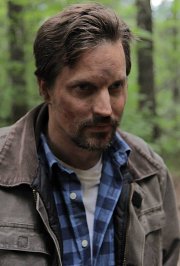
Jason Vail |
I've also been very happy with our critical reception. The cast are
getting high marks and there have been a lot of good words said about the
cinematography and Sasquatch
costume. We even had a recent review say that Valley
of the Sasquatch was the best film the Bigfoot
sub-genre has to offer. I donít
agree with that at all, but to even be spoken of in the same breath as the
classics of Squatchploitation is a huge honor.
Any future projects you'd like to
share? The next thing you can look forward to from The October People
is a little film simply called A. A is a
supernatural thriller written and directed by Elias [Elias
interview - click here], who hooked us up with
our lead actors in Valley
of the Sasquatch. Itís a character study about a man who
is obsessed with the death of his sister when he was five. This obsession
leads him down a dark path that threatens to tear his world apart. I will
be acting as a producer alongside my October People
cohorts. We currently
have Tristan Risk (American Mary) and Nicholas Wilder (Gut)
attached to star.
Beyond A, we also have some scripts ready to go for Jeremy Berg (Valley
of the Sasquatch
cinematographer and director of The October Peopleís first two
features) [Jeremy Berg
interview - click here] to direct. Iím also currently working on my next screenplay,
which is an adaptation of a novel by a local Washington author. Itís a
ghost story told through the prism of a dark domestic drama. Iím really
excited about it because the novel freaked me out and I find the
characters fascinating. Iím aiming for that adaptation to be my next
project as a director. Your/your movie's website, Facebook, whatever
else?
 |
Feeling lucky?
Want to
search
any of my partnershops yourself
for more, better results?
(commissions earned) |
The links below
will take you
just there!!!
|
|
 |
Iím on Twitter @October_John and you can find out
all about Valley
of the Sasquatch at
valleyofthesasquatch.com.
The film is also on Facebook
(facebook.com/valleyofthesasquatch)
and Twitter (@Sasquatchhorror). For information on The October Peopleís other films, a few of which I helped write, you can check out
theoctoberpeople.net,
facebook.com/theoctoberpeople,
or @October_People on Twitter. Anything else you are dying to mention and I have
merely forgotten to ask? Iíd be remiss if I didn't mention
some of my favorite Bigfoot
films. This is a sub-genre that most
people assume begins and ends with Harry and the Hendersons, but
there is so much more out there! If youíre into docudramas (a precursor
to found footage) you canít beat The Legend of Boggy Creek or Sasquatch:
The Legend of Bigfoot. For straight narratives, Iím a big fan of
Creature from Black Lake and Abominable. If documentaries are more your
style Iíd recommend Not Your Typical Bigfoot Movie and any episode of
Unsolved Mysteries or In Search Of that covers the creature.
Thanks for the interview!
Thanks
for letting me ramble!
|